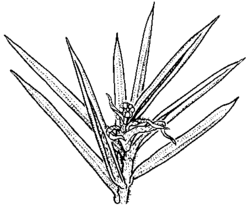Grevillea juniperina subsp. trinervis (R.Br.) Makinson APNI* Synonyms: Grevillea trinervis R.Br. APNI*

Description: Spreading low shrub 0.5–1.2 (-2) m tall, or rarely prostrate; branches spreading, not columnar, the leaves usually clustered on short lateral branchlets.
Adult leaves often dark green with contrasting pale veins, narrowly ovate to narrowly elliptic, 10–20 mm long, 1.5–2.5 mm wide, ±flat with the upper surface venation prominent and conspicuous with 3 (-5) longitudinal veins; margins shortly recurved or shortly refracted; lower surface exposed, densely subsericeous; juvenile leaves broader (to 4 mm wide) and flatter than adult leaves, with scattered hairs below.
Flower colour: perianth and style dull orange to yellow or sometimes red; style-end and pollen-presenter straw-coloured to green. Perianth subsericeous outside, with biramous hairs only. Pistil 21–26 mm long.
Flowering: Flowers mostly August–December, sporadically later
Distribution and occurrence: Occurs in the Central Tablelands of N.S.W., western Blue Mtns at higher altitudes from Hampton and Bindo Ck area S to Jenolan State Forest and Boyd Plateau, NW historically perhaps to Orange area.
NSW subdivisions: CT
Text by R.O. Makinson
Taxon concept: R.O. Makinson (Fl. Australia)
APNI* Provides a link to the Australian Plant Name Index (hosted by the Australian National Botanic Gardens) for comprehensive bibliographic data
***The AVH map option provides a detailed interactive Australia wide distribution map drawn from collections held by all major Australian herbaria participating in the Australian Virtual Herbarium project.
|


